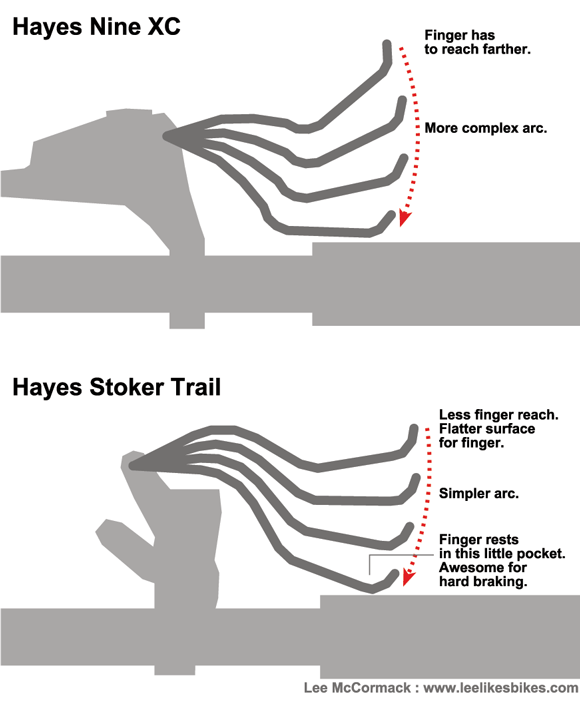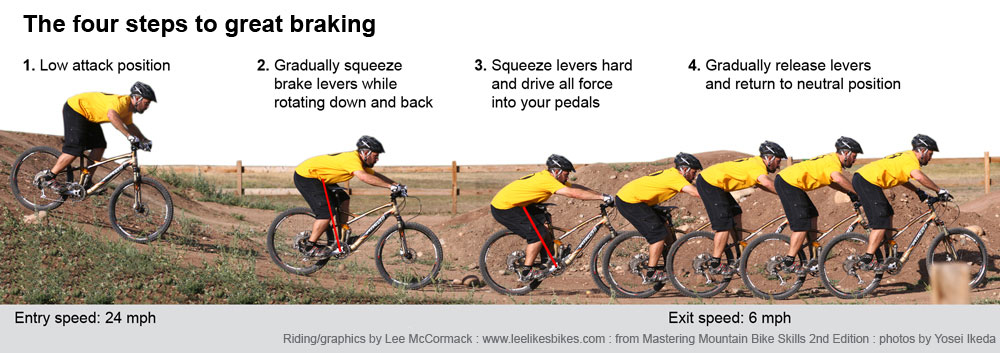Check out the new Hayes Prime brake

As a member of the Hayes Test Program, it’s my duty (and honor) to tell you a bit about the new Prime brake.
Updated Feb. 11 with FAQ and photos.
Three years on Strokers
 Here’s why I get the big bucks. |
The Prime supercedes the Stroker.
I have a pair of production Strokers on my Stumpy, and I still have a set of unfinished billet protos on my 2007 Enduro. I like these brakes. More specifically:
– I like the feel of the lever. Check out the sweet diagram.
– The power works well in most situations. I do wish for more power when I ride my Stumpy where downhill bikes belong, but that’s to be expected.
Here’s a Stroker writeup from January 2008.
 You can stop plenty fast with Strokers and 6-inch rotors. By my calculations, this represents 1.6G of deceleration. Watch that fork flex! The undeniable radness of braking |
Looking forward to the Prime
 |
I’ll be getting a pre-production set of Primes, and I’ll tell you all about them. It’ll be interesting to compare them back-to-back with the Strokers.
Here are the Prime’s salient features, according to the Hayes Prime site.
– Better reach adjust. It’s independent of the contact adjustment, and the mechanical advantage remains constant regardless of the lever position. I like the sound of this; I prefer to run my levers relatively close to the bars, but I like having lots of space between the pad and rotor (because my rotors are all bent).
– More mechanical leverage. The lever delivers more squeeze throughout the stroke, with a gradual ramp-up toward the end. That means more braking power, but with modulation. Sounds good.
– 20% greater hydraulic ratio than the Stroker. Even more finger power with less finger power. Sweet.
– Stronger hose. The new four-layer hose contains the increased pressure for precise feel.
– Hayes Tube Tops. “Protect the frame’s head-tube and headset cup finish from abrasion and wear at the point where the hydraulic hose makes contact.” Not something I worry about, but I’m sure some of you will love it.
– New rotor. New two-piece design is quieter, lighter and stiffer than the old one. Available in 140, 160, 180, 203 and 223 mm. When did we get 9-inch rotors?!?
– Nicer hardware, better bushings and a two-piece clamp. I am all about the two-piece clamp. It lets you fiddle with the brake without undoing your shifters and grips.
I’m especially interested in the increased power. Stay tuned!
— Lee
Hayes Prime FAQs
Added Feb. 11, 2010. From Hayes.
How much is it and when will it be in shops?
The Pro level will have an MSRP of $209 USD. The Expert will be $175 USD. Very aggressive prices for full tool free reach and stroke adjust brakes. They will be available in shops this JUNE.
What makes it a “floating” rotor?
The outer rub-ring of the new two-piece rotor is stainless steel. The inner carrier is aluminum. When the rub-ring gets hot it is able to expand or grow without affecting the carrier. Once it cools it returns to its original shape/size. This is the float part.
(Floating rotors tend to stay in better alignment with the pads. They aren’t as likely to drag when hot. — Lee)
Will the Prime Pro be even lighter w/o the hose cover?
The Prime Pro is lighter than the Prime Expert, due to titanium bits and the lighter two-piece rotor.
Why is the Poppet Cam (stroke adjust dial) blurred out on the new website?
This is the new technology for Prime and all Disc brakes. We didn’t want to “blow our load” all in one shot. We will reveal all of the information regarding Poppet Cam and the guts of the Prime in two weeks.
Can you match the Prime lever with an Ace four-piston caliper?
Yes, but you will lose power and feel. The Prime is more powerful than Ace in part due to the caliper.
Are the Prime levers carbon?
Nope, the levers are forged aluminum … for now.
Are the new Prime pad compounds full-mets and semi-mets?
They are sintered or full metallic in the Pro and Semi-metallic in the Expert. They have a quicker burnish time than previous pads and produce LESS noise.
Click here for the Prime fact sheet (pdf)
Hayes Prime images
Added Feb. 11, 2010. From Hayes.
 |
 |
 |
 |
 |
 |

Comments are closed.